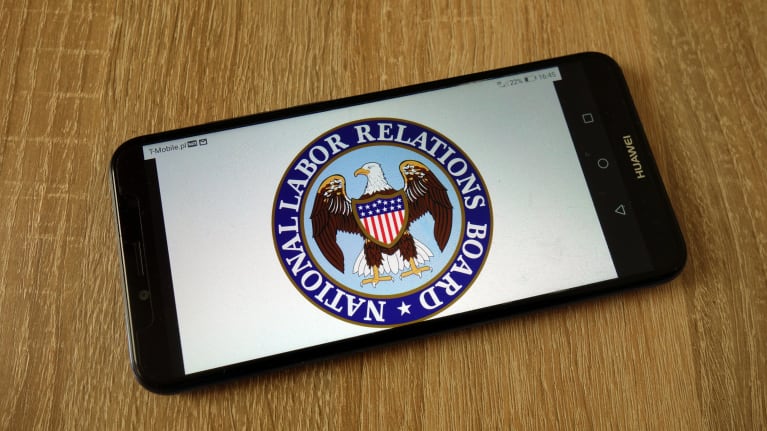
John Ring served as chairman of the National Labor Relations Board (NLRB) from April 12, 2018, to Jan. 20, 2021. On Dec. 16, 2022, he finished his tenure as a member of the NLRB, and he is now a lawyer at Morgan Lewis in Washington, D.C.
While chairman, Ring addressed many issues that are important to employers, such as the joint employer doctrine, the independent contractor standard under the National Labor Relations Act (NLRA), and union election procedures. He began a rulemaking initiative to provide greater clarity in NLRB enforcement and oversaw a review of the agency’s ethics programs. In addition, Ring led efforts to streamline the NLRB’s case-handling procedures, reducing its backlog to a historic low.
and union election procedures. He began a rulemaking initiative to provide greater clarity in NLRB enforcement and oversaw a review of the agency’s ethics programs. In addition, Ring led efforts to streamline the NLRB’s case-handling procedures, reducing its backlog to a historic low.
In an interview with SHRM Online, Ring gave an overview of the NLRB’s priorities in 2023.
SHRM Online: Following your departure from the NLRB, what significant decisions has the board made in the past few weeks?
John Ring: Since I left the board on Dec. 16, there haven’t been any major decisions. But leading up to the end of my term, the board issued several decisions that will have a significant impact on employers. One involves union organizing for smaller groups and brings back the so-called micro-units standard that will make it easier for unions to organize.
The board also issued a decision that adds new monetary liability for labor law violations. This could add significant additional financial risk for employers.
In addition, the board issued decisions that put new limitations on employer private property and management rights.
Over the last year, the board has proposed changes in several other areas important to business, including the joint employer standard, the definition of independent contractor and the board’s approach to employer handbook rules and investigation confidentiality. Additionally, the NLRB general counsel is advocating for the board to make major changes in union election procedures that could eliminate secret-ballot elections and outlaw employer so-called captive audience speeches.
As all these issues suggest, we should expect a lot of activity from the NLRB in the coming year. If not already doing so, businesses need to pay close attention to what the NLRB is doing.
SHRM Online: What is changing about the board’s approach to handbook rules?
Ring: The NLRB took up the Boeing case, regarding handbook rules, in 2017, which set a precedent for the board’s treatment of employer work rules, policies and handbook provisions.
As we know, it is critical for employers to be able to maintain basic written guidance for their employees and, in doing so, have some certainty about which rules the NLRB will consider lawful or unlawful. After a series of previous NLRB decisions made many commonplace work rules unlawful and created confusion about which written work rules passed muster, this decision was an effort by the board to reverse this course.
The decision created a framework that ensured work rules would be lawful if they did not explicitly restrict activity protected by the NLRA. Under the NLRB decision, for example, written employer rules covering confidentiality, nondisparagement, social media, media communication, civility and offensive language were generally considered to be lawful.
In January 2022, the board signaled that it was preparing to overrule the Boeing decision and potentially return to the previous standard that could put employer rules and handbooks back in flux. Until we see exactly what new standard the board adopts, it is difficult for employers to know whether their rules will once again be considered unlawful. This topic of rules, policies and handbooks is one that employers—whether unionized or nonunion—need to watch carefully.
SHRM Online: Might the board adopt NLRB General Counsel Jennifer Abruzzo’s recommendation to make “captive audience” meetings unlawful? What effect would that have on employers?
Ring: NLRB General Counsel Jennifer Abruzzo has been transparent about her priorities, and she has announced a number of policy initiatives since taking office. One of those initiatives, contained in GC Memorandum 22-04 issued on April 7, 2022, seeks to make unlawful mandatory meetings held by employers addressing Section 7 activity—including meetings in response to union organizing. The general counsel has asked the board to change the law in this area and announced her intention to prosecute employers who hold such meetings.
For almost 75 years, the NLRB has permitted employers to hold mandatory meetings during work time in which employers explain their position on unionization. These meetings often occurred in the days and weeks prior to an NLRB secret-ballot election. There has been no legal debate, at least for decades, over the lawfulness of these meetings—labeled “captive audience meetings”—if unaccompanied by other coercion or restraining conduct.
While I cannot predict what the board will do, the general counsel’s position on captive audience speeches is certain to be challenged in court. This is an area that could have a major impact on employers’ ability to communicate with and fully inform employees, particularly during organizing campaigns.
SHRM Online: If the board changes the joint employer standard as it has proposed to do, what effect might this have on employers?
Ring: The joint employer standard is critically important for a number of industries, particularly in the franchising and staffing sectors. While I was NLRB chairman, we issued a rule that restored the NLRB’s decades-old joint employer standard that required direct and immediate control over terms and conditions of employment. In developing that rule, we sought input from the public and did exhaustive work to make sure it addressed all the issues that were raised. And we used rulemaking as opposed to case adjudication—which is how the board has traditionally carried out its work—to provide better guidance and clarity on this important issue.
In a notice of proposed rulemaking published on Sept. 7, 2022, the current board proposed an initial regulation that would fundamentally change the definition of “joint employer,” replacing the prior legal standards with vastly broader ones and likely sweeping many more business relationships under its coverage. The bottom line for businesses is that the notice of proposed rulemaking contains a standard for joint employer status that both is broader and provides less guidance than the NLRB’s previous standard. The board has indicated that it intends to issue a new joint employer rule by August.
SHRM Online: Abruzzo has called for “full interim relief” for the NLRA under 10(j) injunction actions. What are 10(j) injunction actions? How is this announcement significant?
Ring: Section 10(j) of the NLRA gives the NLRB’s general counsel the authority to seek injunctions in federal court to immediately stop labor law violations. The general counsel will seek so-called 10(j)s once the investigation of the case is complete, but before it is decided by the board, which often can take a long time. Abruzzo has indicated she intends to “aggressively” seek more 10(j)s and has instructed the NLRB regional offices to swiftly identify any case where potential injunctive relief may be appropriate.
When faced with a 10(j) injunction action by the general counsel, employers often will consider a settlement to avoid litigation. Indeed, settlements represent a large majority of how cases are resolved at the NLRB.
However, the general counsel has made it more difficult to settle 10(j) cases. In GC memoranda—GC Memorandum 21-07 and GC Memorandum 21-08, issued in September 2021—the general counsel has called for “full remedies” to be sought in all cases, including settlements. In calling for “full remedies,” she has proposed a number of new remedies not previously approved by the board and well beyond the traditional relief sought by the agency. These new remedies include things such as front pay, letters of apology from the employer, and broader dissemination of notice postings, including on social media. The general counsel also wants the regions to take an expansive view of the monetary “consequential damages” that can be assessed in connection with the new broader make-whole relief adopted by the board. Employers seeking settlements in 10(j)s and other cases are being confronted with these expanded demands and must choose to accept them or forgo settlement.
SHRM Online: Abruzzo also has called for preventing intrusive electronic monitoring that would infringe on NLRA rights. How is this a significant development?
Ring: In GC Memorandum 23-02, issued on Oct. 31, 2022, Abruzzo announced a new and unprecedented prosecutorial initiative aimed at employers that use technology to monitor and manage employees in the workplace. In the memo, the general counsel urges the board to “adopt a new framework for protecting employees from intrusive or abusive forms of electronic monitoring and automated management that interfere with Section 7 activity.” Given the vague and uncertain nature of this memo, it is difficult to know its full implications. However, employers that use technology in connection with the management of employees should watch this issue carefully.
While it is probably premature to consider any operational changes in response to this initiative, employers might consider undertaking a pre-emptive “stress test” exercise that assesses a potential NLRB investigation and corresponding request for information on the scope of electronic monitoring and related systems in the workplace, as well as any written policies or protocols describing those systems.
SHRM Online: What other changes are on the horizon that are worth employers’ attention?
Ring: Everything suggests that employers should expect to see high-profile unionization efforts and a continuation of increased employee activism. Over the last several years, employees seem more willing to advocate for their rights and confront their employers on workplace and other issues, including larger social justice concerns.
Employees aren’t limiting themselves to the traditional playbook. Although some are seeking out established unions for representation, others are forming their own homegrown unions. Many employees are taking to social media or other types of nontraditional bargaining campaigns to advocate for themselves. Regardless of how employees express themselves, there seems to be more of it, and it represents additional areas of risk, potential exposure and reputational concern for employers.
Looking at what might be on the horizon from the NLRB, there are many areas employers need to be watching carefully. On that list I’d put the joint employer standard, the independent contractor standard, and changes in union organizing procedures. Obviously, for issues such as joint employment and independent contractors, whole segments of the economy have structured their business arrangement under one set of rules, and any change could be very disruptive.
SHRM Online: Overall, what direction do you see the NLRB now headed in, and what does that mean for employers?
Ring: The NLRB is responsible for maintaining an important balance in our labor law: protecting employees’ rights on the one hand and upholding employer interests, including those of managing their businesses, on the other. I’m proud of the work the board did while I was chairman to restore the historic balance on many important issues. I am also proud of the work we did to make our labor law more accessible and understandable, which I believe is of benefit to employers as they try to comply with the law. What we are seeing from the current NLRB is a change in the balance that affords more protections to employee rights, and there is focus on issues that could lead to precedential and pendulum-swinging decisions. The changes on deck will move labor law further in the direction of facilitating union organizing and make employer conduct that was once lawful now be a violation.

